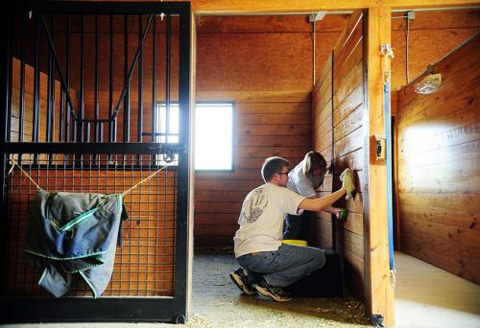
By Dr. Karen Hayes and Sue Copeland
From the Equisearch website
Do you know how to disinfect a stall, horse clothes, or brushes to keep disease from spreading at your barn? We’ll guide you through the process.
In the June 2005 issue of Horse & Rider magazine we talked about the importance of a clean barn in keeping disease at bay. But if sickness does strike, you may have to disinfect a stall that’s been inhabited by a sick horse, or disinfect horse clothing and other objects. Here’s how.
To Disinfect a Stall:
Remove all bedding.
Remove all removable objects, such as buckets and feeders. Using a mixture of hot water and dish detergent, scrub them free of residue. Rinse thoroughly, then scrub again with a solution of 1 part laundry-type chlorine bleach to 10 parts water. Allow them to air-dry without rinsing. Scrub one more time with hot water and dish detergent. Rinse thoroughly to remove any bleach or detergent residue.
Sweep cobwebs, dust, hay, etc., from the stall floor, walls, ledges and door.
Wash walls and other solid surfaces using a pressure washer (or garden hose), a stiff scrub brush, and dishwashing detergent.
Mix Lysol Disinfectant Concentrate (2 q/2 tablespoons per gallon of water) in a garden-type spray tank. Wear protective clothing, including long sleeves, long pants, gloves, goggles and head gear. Spray a soaking mist of disinfectant onto all surfaces and allow to air-dry. Repeat.
Return clean buckets and feeder to your horse’s stall. Bed with clean bedding.
To Disinfect Yourself: After handling a sick horse:
When entering the horse’s stall or paddock: Wear rubber boots and close-weave fabric overalls with long sleeves. Confine your hair in a hat. Use disposable latex or rubber examination gloves whenever working with or around a sick horse. Leave these garments at the stall door or paddock gate, where they can be donned before entering and taken off when you leave.
Upon leaving the horse’s stall or paddock: Discard the used disposable gloves in a closed receptacle outside the enclosure. Disinfect your boots with a plastic scrub brush and Lysol Disinfectant Concentrate (2 1/2 tablespoons per gallon of water) in a dishpan or bucket. Leave the boots outside the enclosure to dry. Cover or discard Lysol solution for safety (it’s toxic if swallowed.)
When tending to more than one horse, take care of the sick one last.
To Disinfect Your Grooming Tools:
Clean your brushes and grooming tools at least once a month to help prevent skin problems from developing and spreading, particularly if grooming tools are shared among several horses.
Remove all hair.
Soak and scrub your brushes and tools in hot water and dish detergent to loosen and remove all oils, dander, scabs and other residue.
Prepare Lysol disinfectant solution (2 1/2 tablespoons per gallon of water); soak all grooming tools for 30 minutes. Discard solution. Allow tools to air dry, preferably in the sun. (Note: Wooden-handled tools might be damaged by soaking. Use tools that are made of materials that can be soaked safely–such as plastic or metal.)
To Disinfect Saddle Pads and Blankets:
Clean blankets and pads weekly or monthly, depending on how frequently they’re used. Doing so will help prevent skin problems from developing and spreading.
Remove hair with plastic brush and/or vacuum cleaner. Discard vacuum bag.
If machine-washable, run pads through the wash cycle with Lysol. (Use 1 cup in a standard top-loader.) Spin dry and run through a second wash cycle with Ivory soap flakes. Add vinegar to the rinse water to help remove soap residue. (Use 1 cup in a standard top loader. Some horses have a skin-sensitivity to detergent residues in saddle pads and blankets.) Tip: If your washing machine is too small to wash saddle-pads, inquire at local Laundromats for permission to use their machines. Most will allow this, but will require you to run the machines once more, empty, to remove hair and other residue.)
Allow to air-dry, preferably in the sun.
